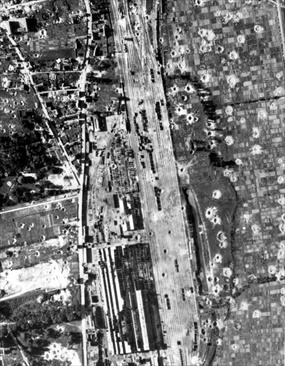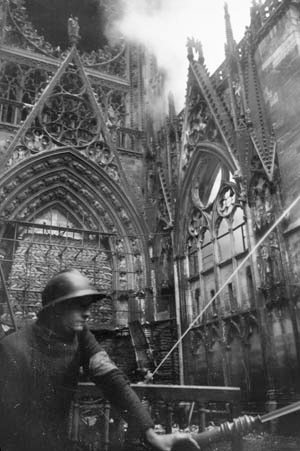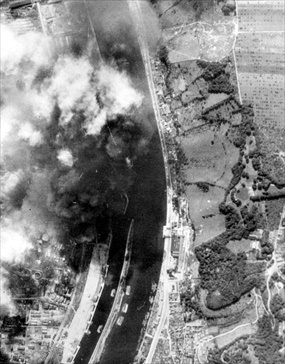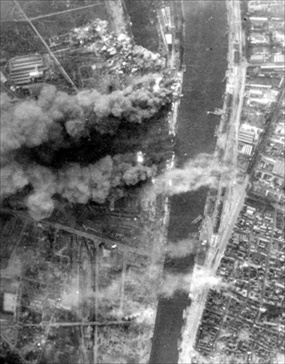U.S. EIGHTH AIR FORCE TESTS DAYLIGHT PRECISION BOMBING
Rouen, Normandy, Occupied France • August 17, 1942
On July 4, 1942, a dozen Douglas A-20 Havoc medium bombers took off from a small, grassy airstrip in Norfolk, about 100 miles/161 km northeast of London, England, and headed for Nazi-occupied Holland. Half the bombers were American, part of the U.S. Army Air Force’s Eighth Air Force 15th Bombardment Squadron, and momentarily attached to No. 226 Squadron of the Royal Air Force. The Independence Day raiders inflicted minimal damage on 4 Dutch airfields for the loss of 1 RAF and 2 American crews. It was the first strike against Nazi-occupied Europe involving American bombers and aviators.
The next month, on this date, August 17, 1942, the USAAF began the opening attack of its round-the-clock strategic bombing campaign against the Nazi enemy, having overcome the lack of long-range heavy bombers. The mission of the 97th Bomb Group was an experimental daylight strike by 12 4‑engine Boeing B‑17E Flying Fortresses against French railroad marshaling yards in Rouen’s suburb of Sotteville, 35 miles/56 km inland from the English Channel. Escorting the heavy bombers were 4 squadrons of RAF Supermarine Spitfire fighters. The first bomber off the airstrip in Northamptonshire, England, was flown by boyish Maj. Paul Tibbets, who 3 years later would pilot the B‑29 Superfortress Enola Gay on another first-of-its-kind mission against Hiroshima, Japan.
The sortie against Rouen-Sotteville was moderately successful. Flying at 23,000 ft./7,010 m, the warbirds unloaded 18.5 tons of 600 lb./272 kg bombs. About half the bombs fell within the target area, the rail yard; a roundhouse and some rolling stock were destroyed, about a third of the track lines were damaged, and 2 large transshipment sheds were hit. The remaining bombs fell on commercial and residential areas about 2,000 ft./610 m to the south of the aiming point, killing 52 civilians and wounding 120. A larger follow-up raid on the same rail yard a month later was more inaccurate, killing 140 civilians and wounding 200. No bombers were lost to flak or enemy planes on either raid. After the first Rouen raid Maj. Gen. Carl “Tooey” Spaatz, first commander of the Eighth Air Force, telegraphed Gen. Henry “Hap” Arnold, chief of the Army Air Forces: “The attack on Rouen far exceeded in accuracy any previous high-altitude bombing . . . by German or Allied aircraft. Moreover, it was my understanding that the results justified ‘our belief’ in the feasibility of daylight bombing.” With these words the myth (or lie) of daylight precision bombing was given a huge organizational boost.
For the next 10 months the Rouen air strategy pushed by Spaatz, Arnold, and Brig. Gen. Ira Eaker, commander of the VIII Bomber Command, the bomber component of the Eighth Air Force, was distinguished by one significant modification; namely, the daylight precision bombing of enemy industrial and military targets was conducted most of the time by unescorted, not escorted heavy bombers, which, like the July 4, 1942, raid in Holland, took a heavy toll on Allied aircrews. However, the theoretical versus the actual success of dropping ordinance precisely on a target area was just as debatable as when Spaatz touted the success of the Rouen airstrike to Arnold in August that year. The next year, 1943, Allied aerial bombings killed nearly 7,500 French men, women, and children. The number of French civilians who perished in Allied aerial bombings before, during, and after their country’s liberation in 1944 might be as high as 70,000, with 100,000 wounded.
In the 5 years between May 1940 and V‑E (Victory in Europe) Day, May 8, 1945, close to 1,600 French towns and cities were on the receiving end of Allied air strikes and artillery fire. Particularly along the French coast, Allied troops and French resistance fighters found themselves liberating giant mounds of bricks, timber, and roofs as they moved through knots of sullen residents picking through the wreckage of their homes and businesses, burying their dead, and caring for survivors. On August 31, 1944, Canadian forces entered the once beautiful city of Rouen. Like the rest of France, Rouen had paid a steep price for its liberation.
Bombing Our Friends to Hurt Our Enemy: The Agony of Rouen, France
 |  |
Left: A damage-assessment photograph after an American air raid on July 8, 1944, on the Rouen-Sotteville marshaling/classification yards shows extensive cratering; the German occupiers—and French railroad workers—were usually able to repair the damage quickly. Because it was a major transportation and communication hub on the Seine River, Rouen was bombed more than 2 dozen times by B‑17s, B‑24s, Avro Lancasters, A‑20 Havocs, B‑26 Mitchell Marauders, and RAF DeHavilland Mosquitos, the latter 3 bomber types being twin-engine. Beginning on March 12, 1943, bombers hitting Rouen were escorted by RAF Spitfires flying out of English airfields.
![]()
Right: Rouen firefighters work to extinguish flames inside the city’s historic Notre Dame Cathedral, which dated from the 1100s. The tall, majestic, delicately spired cathedral suffered severe damage on the night of April 18/19 and again on May 31, 1944. Gen. Dwight D. Eisenhower, the person in charge of the Allied invasion of France, had directed the USAAF and RAF to begin striking at major transportation centers like Rouen to make them unusable to the Germans. The April raiders successfully plastered the Sotteville marshaling yards with incendiaries in their first salvo. Their second fiery salvo hit residential areas and Rouen’s magnificent Gothic cathedral lying miles/kilometers from the rail yards. A few blocks from the cathedral France’s largest Gothic-style civic building, the Palace of Justice, was gutted by fire. In Sotteville alone more than 2,200 buildings were destroyed in the conflagration along with 900 civilians. By the end of May 1944 40,000 Rouennaisse had been rendered homeless. Harrowing destruction like this and elsewhere across France, even if accidental, sorely tested French morale on the eve of D-Day, the June 6, 1944, start date of France’s liberation from German occupation and Vichy French collaborators.
 |  |
Left: Smoke pours from a Rouen oil depot during a raid by the U.S. Eighth Air Force in August 1944. By the time of this raid, precision delivery of bombs had increased tremendously overall. Eighth Air Force typically put 31.8 percent of its bombs within 1,000 ft./305 m of the aim point from an average altitude of 21,000 ft./6,400 m. U.S. Ninth Air Force low-level fighter bombers turned in a better performance; for example, destroying 75 percent of the 24 bridges between Rouen and Paris by D‑Day.
![]()
Right: Thick black smoke rises along Rouen’s Seine river front as Ninth Air Force A‑20 Havoc and B‑26 Mitchell Marauder medium bombers hit German forces fleeing the city, late‑August 1944. The retreating German Army, lacking bridges to cross, resorted to ferries, which were under rocket and artillery attack from the air. When Canadian infantry entered Rouen on a rainy August 30, the German enemy was gone.
Contemporary Newsreel of U.S. B-17s Bombing Rouen, France, August 17, 1942
![]()

 History buffs, there is good news! The Daily Chronicles of World War II is now available as an ebook for $4.99 on Amazon.com. Containing a year’s worth of dated entries from this website, the ebook brings the story of this tumultuous era to life in a compelling, authoritative, and succinct manner. Featuring inventive navigation aids, the ebook enables readers to instantly move forward or backward by month and date to different dated entries. Simple and elegant! Click
History buffs, there is good news! The Daily Chronicles of World War II is now available as an ebook for $4.99 on Amazon.com. Containing a year’s worth of dated entries from this website, the ebook brings the story of this tumultuous era to life in a compelling, authoritative, and succinct manner. Featuring inventive navigation aids, the ebook enables readers to instantly move forward or backward by month and date to different dated entries. Simple and elegant! Click 











